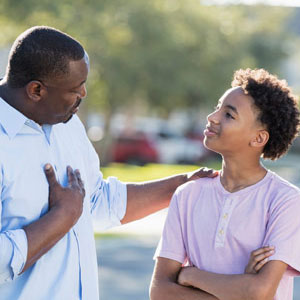Sports and Exercise Safety
Did you know that playing tennis with a badly strung racquet while wearing worn-out shoes can increase your risk of injury almost as much as playing football without shoulder pads? Using the wrong — or not properly fitted — equipment is a major cause of injuries.
Helmets Are Key
The equipment you wear while participating in sports and other activities is key to preventing injuries.
Start with helmets: They're important for sports and activities such as football, hockey, baseball, softball, biking, lacrosse, horseback riding, skateboarding, inline skating, skiing, and snowboarding — to name just a few. Helmets reduce the risk of head injuries 75%–85%.
- Always wear a helmet made for the sport you're playing.
- Your helmet should be cared for, fit well, worn consistently and correctly, and certified for use.
- When choosing a bike helmet, look for a sticker that says the helmet meets the safety standard set by the Consumer Product Safety Commission (CPSC), a federal regulatory agency that creates safety standards for bike helmets and other safety equipment.
- Multi-sport helmets used for inline skating and skateboarding aren’t considered safe for bicycle riding unless they have the CPSC sticker.
- Need to find the right helmet size for you? Wrap a soft tape measure around your forehead, just above your eyebrows and ears. Then match your head size to the corresponding helmet size.
- Helmets should fit snugly but comfortably in a horizontal position on your head and shouldn't tilt backward or forward. The straps should form a “V” around your ear and the buckle should be fastened at all times.
- Every helmet should be replaced after any accident, as there can be more damage you can’t see.
- Football helmets must be certified by the National Operating Committee on Standards for Athletic Equipment (NOCSAE).
Note: Helmets greatly reduce injury-related fatalities, but they do not protect against concussions.
Eye Protection
Eye protection also is a must for many sports. Sports participation is the leading cause of eye injuries in teens, but proper fitting protective eyewear can reduce the risk of serious eye injury by 90%.
- The most protective eye gear is made of polycarbonate or Trivex lenses and has been tested especially for sports use.
- Facemasks or polycarbonate guards or shields that attach to a helmet are worn in sports such as football, ice hockey, lacrosse, softball and baseball when batting.
- Goggles are often worn for soccer, basketball, racquet sports, snowboarding, street hockey, lacrosse, paintball, baseball, and softball when fielding.
- If you wear glasses, you'll probably need prescription polycarbonate goggles. Don't just wear your regular glasses when you're on the court or field. Contact lenses don’t provide protection.
- All eye protection should fit securely and have cushions above your eyebrows and over your nose.
- Eye protection should be replaced if damaged or starting to yellow with age.
- Eye protection also can protect you from ultraviolet radiation when skiing, mountain climbing, or doing water sports.
- Eye protection may also protect against irritants that could become dangerous like bugs while cycling.
- All eye protection should meet the standards of the American Society for Testing and Materials (AMTM).
More Essential Equipment
Mouthguards can protect your mouth, teeth, and tongue:
- Mouthguards are recommended for all contact sports to reduce dental trauma.
- Wear a mouthguard if you play a contact sport where head injury is a risk, such as football, lacrosse, basketball, hockey, volleyball, martial arts, boxing, or wrestling.
- Mouthguards can be fitted for your mouth by a dentist or purchased at sports stores.
- Keep your mouthguard clean and rinse it between uses.
- If you wear a retainer, always take it out before you start to exercise, practice, or play.
Wrist, knee, and elbow guards are important gear too:
- If you inline skate, snowboard, skateboard, or ride a scooter, you should wear guards.
- Elbow and wrist guards can prevent arm and wrist fractures, and knee guards can shield your knees from cuts and breaks.
In some sports, especially contact sports, pads are essential:
- All kinds of sports, from hockey to volleyball, and soccer to inline skating, use pads. There are shin, knee, elbow, wrist, chest, shoulder, hip, and thigh pads.
- Check with your coach or doctor to find out what kinds of pads you might need for your sport.
Some guys may also need to wear a protective cup (to protect the groin area):
- Guys who play hockey, football, basketball, baseball, soccer, and other contact sports should use a cup.
- For noncontact sports that involve running, guys should wear an athletic supporter.
- If you're unsure, ask your coach, athletic trainer, or parent if you need a cup for your sport.
And last but not least, the right footwear can keep you from tripping and falling:
- You know that sports like football, baseball, softball, and soccer require cleats. But you may not realize that sports like skateboarding and biking need special types of shoes, too. Ask your coach or doctor what shoes are best for your sport.
- Replace shoes and cleats that have worn out or are no longer supportive.
Not only is the right kind of equipment important, so is the right fit. If you don't know if your equipment fits properly, check with a coach, gym teacher, athletic trainer, or parent to make sure you have the right size and that you're wearing it correctly. Many sporting goods stores can also help you find the right fit.
The bottom line: Wearing the right equipment with the right fit greatly lowers your risk of getting hurt.
Warming Up and Stretching
Don't rush into any sport or exercise without warming up first. Muscles that have not been properly prepared tend to be injured more easily.
Start out with some light cardiovascular activities, such as jogging, jumping jacks, shuffling, high knees, or butt kicks. They’ll increase your heart rate and body temperature, and warm up your muscles. Follow your 10-minute warm-up with some dynamic stretches. (Stretching works best after a warm-up because your tissues are more flexible due to the increase in heat and blood flow to the muscles.)
Don’t forget about stretching too. Do some before play. Dynamic stretches to do before exercises include toe walking, heel walking, forward lunges, side lunges, toy soldier, inchworm, and arm circles.
Do static stretching after activity to avoid stretching the muscles too much for hard work. Slowly stretch a muscle to the point of mild discomfort and then hold the position for 30 seconds. Static stretches include standing quadriceps stretch, hamstring stretch, calf stretch, shoulder stretch, wrist stretch, groin stretch, back stretch, iliotibial band stretch, triceps stretch, and chest stretch.
Besides warm-ups and stretches, practice sessions are also excellent preparation for many sports or activities. If you belong to a team, attend as many team practices and games as you can. It is important to work your way up to full participation by practicing. Typically, you should start 3 weeks before the start of your season to get in shape. This will put you in top physical condition and help you and your teammates work together. And knowing how your teammates play will help prevent injuries.
Even if you don't belong to a team, you can use regular workouts and practices to enhance your performance and lessen the chance of injuries. Keep yourself in top shape with regular practice. For instance, try doing tennis drills or practicing your serve before starting a set. Shoot some baskets or play a quick game of one-on-one with a friend. Practice gets your brain and body to work together while improving your performance.
Although you should practice regularly, don't overdo it. Sudden increases in training frequency, duration, or intensity might produce better performance at first, but can lead to overuse injuries later. Allow for a day off for rest between days of activity and alternate your activities. If you run a lot one day, alternate with swimming or strength training the next day. Your doctor or coach can help you develop a training and conditioning program that's right for your age and level of development.
When to Come Back After an Injury
If you try to come back too soon after an injury, you run the great risk of reinjuring yourself — maybe even more seriously than before. If you come back to a sport or activity after a long break, slowly increase your activity level by 10% each week until you reach your optimal fitness level. Don't let anyone pressure you into playing before your body is fully healed. Your doctor, coach, or trainer will give you specific advice on when it’s OK to return to your sport or activity.
Taking time to heal is particularly important if you've had a concussion. Lots of athletes try to come back too quickly after getting a concussion — because they can't see an injury, they think they're OK to play. But jumping back into the game too soon puts a player at greater risk for another concussion, and other even more dangerous brain injuries. It’s a rule in many states to get clearance from your doctor to play again if you've had a concussion. Your doctor will come up with an individualized plan for you.
Many athletes use pain relievers to avoid pain. If you feel lasting pain, don't use pain relievers to mask it, though. Taking large amounts of pain relievers — or, worse yet, taking pain relievers over a long period of time in order to play — can be dangerous. Pain is the body's way of signaling that something is wrong. If you have pain, talk to your doctor.
Be sure to get medical care whenever you have:
- moderate to severe pain
- pain that interferes with daily activity or sleep
- swelling of the injured area
- numbness or tingling after injury
- a problem doing normal activities
- pain that prevents you from maintaining proper form
- a limp
- a change or decrease in range of motion of a joint
- a decrease in strength
The same advice goes for a cold or flu virus — don't play if you're sick. Do not play when you have a fever. You won't be able to concentrate if your head is stuffed up and your nose is running faster than you are, and your lack of concentration can put you at risk for injury. You can also spread the cold or flu to the rest of your teammates. It's better to wait until you feel better, so you can have a safe season.
The Rules of the Game
Rules and regulations are there for a good reason — to keep you and your teammates in the game and to avoid injuries. Do yourself a favor and learn the rules and then follow them.
Rules aren't restrictions. They're designed to promote safety so that everyone can enjoy the game. For example, a late hit in football after the referee's whistle has blown will lead to a big penalty. This rule is important because a player could be seriously injured if they’re not expecting a tackle after play has stopped.
Sometimes rules may not be directly related to a sport or activity but need to be followed anyway. For instance, if you're inline skating, skateboarding, or riding a bike, pay strict attention to all traffic laws, especially when riding on busy public streets.
Proper techniques and sportsmanship promote safety. This goes for any sport, from motor racing to baseball. Baseball players know not to spike the opposing player who's covering the bag, even when sliding hard into second base. And when two tennis players rush the net, an expertly angled volley is the correct shot — not a hard smash socked directly at an opponent's face!
Another example of a safe technique happens in weightlifting. Weightlifters should take a breath between each repetition. Exhale on the pushing phase of a lift. So if you're doing a bench press, let the bar come down to your chest, and if you're pushing up, breathe out. Holding your breath can raise your blood pressure, hurt your lungs or eyes, and if you're pressing a lot of weight, can cause a blackout or fainting spell.
So when you're sticking to rules, regulations, and proper techniques, remember that they aren't there to restrict you — they're there to keep you safe and injury-free.
-

Concussions
A concussion is a brain injury that happens because the brain has been knocked against the hard bone of the skull. Watch this concussion animation to see what’s happening inside a person’s head.


